Back in the day, it was enough to pay influencers with exposure or products. But as the channel has grown bigger and e-commerce businesses have seen the power of influencer marketing, the way you compensate influencers has also changed.
From upfront payment to pay-per-performance campaigns, there are a multitude of ways you can compensate and pay influencers. In this blog, we’ll go through everything you need to know, so you compensate fairly without emptying your business’ bank account.
In this guide, you'll learn:
5 Ways to Pay Influencers
What affects your compensation?
How much should you pay influencers?
5 Ways to Pay Influencers
As influencer marketing is growing and most businesses are seeing its potential, the way people are working with influencers is changing. From using influencer software to how payment is handled. The way you pay our influencers will have a direct effect on both the influencer you can attract and your campaign results. While there are plenty of different payment methods, there are 5 that are used regularly:
1. Upfront payment
One of the preferred compensation methods for influencers. A fixed amount is paid during the campaign. Together with the influencer you agree on content and a timeline. Especially bigger influencers like to be compensated this way. When and how much you should pay upfront is based on a lot of factors.
Pros: Easy way to attract influencers
Cons: Unpredictable ROI and not sure how much you get out of the partnership
2. Performance-based compensation
A newer way to pay influencers is through performance-based compensation. This means that the amount the influencer gets paid is based on the results that they create for the business.
This aligns the influencer with the business as they both want to create the best results possible.
The influencer is then only paid when a certain action is taken such as:
Traffic (CPM) - A fixed amount is paid for every 1000 impressions on a post. Great for creating brand awareness.
Click (PPC) - A fixed amount is paid for each click on a specific link.
Lead Generated - A fixed amount is paid for each lead generated
Purchase (PPS) - Once a sale is made, the influencer will be paid a percentage of that sale. Typically the percentage range of each sale is from 10%-20%.
Download - A fixed amount is paid for each app download
Booking - When a booking is made, the influencer might be paid a percentage or a fixed amount
Account created - A fixed amount is paid for each account created
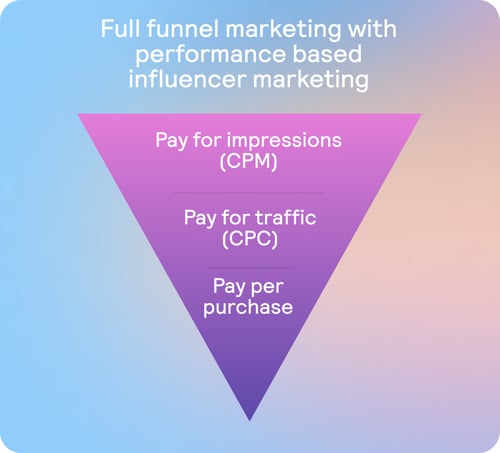
Performance-based influencer marketing allows you to do full-funnel influencer marketing from awareness to decision.
Pros: Aligns influencer and business, knows exactly what to get out of the partnership, easy to scale.
Cons: Requires complex tracking - Want to try performance-driven influencer marketing? Try Make Influence
🤫Want to run a click campaign with influencers?
Use our CPC-cheatsheet. Check it out right here🤫
3. Gifts and Rewards
Used by a lot of businesses when they first try out influencer marketing. The cheapest alternative is paying your influencers with gifts and rewards. This usually works for smaller influencers or if your brand and products are worth enough for the influencer. This compensation method can be used at the beginning of a partnership to “test” out the influencer and thereafter see if you’re happy with the result.
Pros: Cheap
Cons: Tough to recruit good influencers
4. Pay-per-post
A lot of influencers also prefer to be paid per post they make. The price range might differ a lot depending on what type of influencer you work with. Metrics that affect the price might be:
Follower count
Engagement rate
Industry and Niche
Dwayne "The Rock" Johnson can easily make up $1 million per post.
Here he has partnered up with Underarmour.
Big celebrities such as Kylie Jenner and Dwayne “The Rock” Johnson can easily see up to $1 million per post, whereas nano and micro-influencers might be in the price range 20-$100.
Pros: Easy way to attract influencers
Cons: Unpredictable ROI
5. Hybrid payment
An emerging method to pay influencers combines performance-based compensation together with a bonus fixed amount. Initially, influencers agree on performance-based compensation such as CPC or a percentage of each sale. In their contract, there are then more incentives such as a lump sum paid out if they exceed x amount of sales.
This adds a gamification aspect to influencer marketing and is seen as something that really activates the influencer to do their best.
Pros: Best of both worlds: easy to recruit and aligns business and influencer
Cons: Requires performance tracking - For an easy fix, take a look at Make Influence
What affects how you pay influencers?
Different influencers might expect different ways of payment. So what exactly affects how you pay your influencers? Influencer metrics, their followers, your own business, outside factors such as holiday seasons - All these things directly influence (no-pun intended) how much you pay your creators.
The most common factors are:
Follower count
Let’s take a look at the classic influencer metric: Followers. Now there are plenty more metrics to look at when evaluating influencers, but follower count still gives us a pretty good idea of just how big the influencer is.
Are we dealing with a nano-influencer, micro-influencer or a macro-influencer?
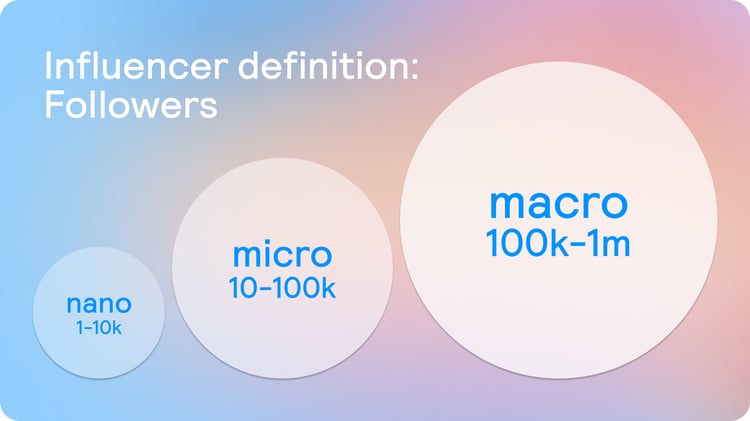
Nano-influencers, influencers with under 10,000 followers, are known for their authentic connections with smaller, engaged audiences. Businesses usually partner up with nano-influencers for cost-effective and niche-specific marketing campaigns, outlining their potential to create genuine, relatable content.
Nano and micro-influencers are much up for payment through pay-per-performance or product gifting, whereas bigger influencers usually expect an upfront payment before collaborating.
But it is not always wise to just pay macro-influencers upfront.
Engagement rate
Looking past follower count, it might be worth it to check out the influencer’s engagement rate to see how you pay them.
While macro-influencers might demand upfront payment, it shouldn’t always be a given, especially if they have low engagement rates.
Engagement rates are usually higher for smaller influencers and also on channels where it is easier to quickly interact with the content such as TikTok.
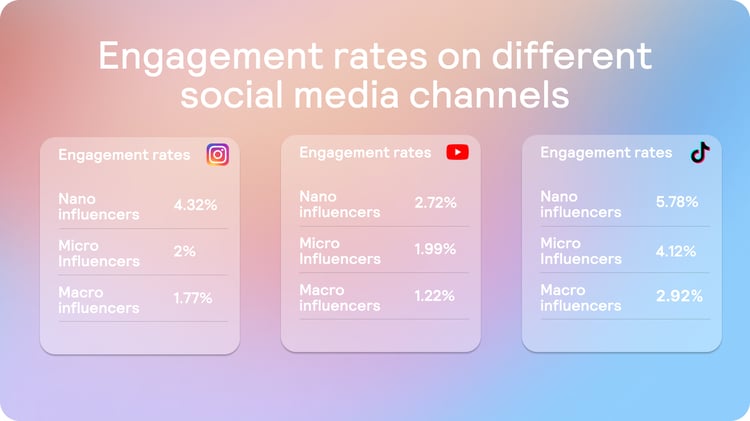
How to calculate engagement rate:
Engagement rate can be a good metric to evaluate if an influencer is worth working with. There are two ways to calculate engagement rate, one by reach per post and one by total followers.
ERR = (Total engagements per post / Reach per post) x 100
ERF = (Total engagements per post / Total followers) x 100
Type of content
The type of content is another crucial factor that can significantly impact how influencers are compensated. The nature of the content an influencer creates plays a pivotal role in determining the value of their collaboration. The more complex and time-consuming the content is - the higher the price tag.
Seasonal demand
Just like everything involving money, influencer marketing is still just supply and demand. If you want to advertise during seasons of high influencer demand such as Black Friday, you can expect prices to be much higher than normal.
Content rights
Repurposing influencer-created content also comes with a higher price tag. Clearly outline in your contract with your influencer how you’re going to use their content and how long you hold the rights, typically up to 2 years.
How much should you pay influencers?
Now we’ve established what types of payment and compensation methods there are and what affects the pay. Now comes the question:
How much should you pay?
Obviously, it depends on what you’re doing upfront, pay-per-performance, or something else. We still tried to be as specific as possible.
How much should you pay your influencers when doing upfront and pay-per-post?
Keeping in mind that prices vary based on a lot of factors, we can still roughly go by the classic rule of 1 dollar per 100 followers. Pricing per post fluctuates from channel to channel, with TikTok being a lot cheaper than something like Youtube.
Source: Influencer Marketing Hub
How much should you pay your influencers when doing pay-per-performance?
How much you should pay per performance depends on two things:
Your business - what are you selling? Cars or clothes?
What action are you paying per? Clicks, purchases, leads?
For example, think about the cost per click. How much are you willing to pay for a click when doing Facebook Ads. Now you have a good benchmark for what to pay your influencer per click they provide.
When it comes to sales we often see the percentage of each sale in the range of 5-20%, but this also depends on product and pricing.
Want to try out pay-per-performance for your influencer marketing? Try out Make Influence today!
Make Influence enables you to recruit, collaborate, and scale with performance-driven influencer marketing. Book a demo and get a tour of the platform today.









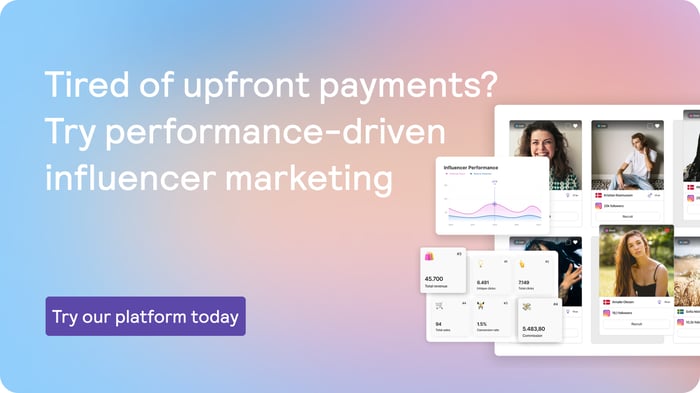
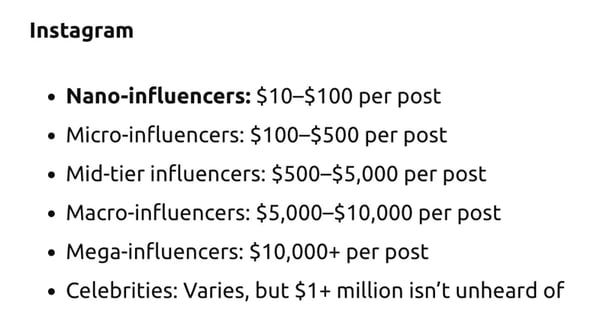
Skriv en kommentar